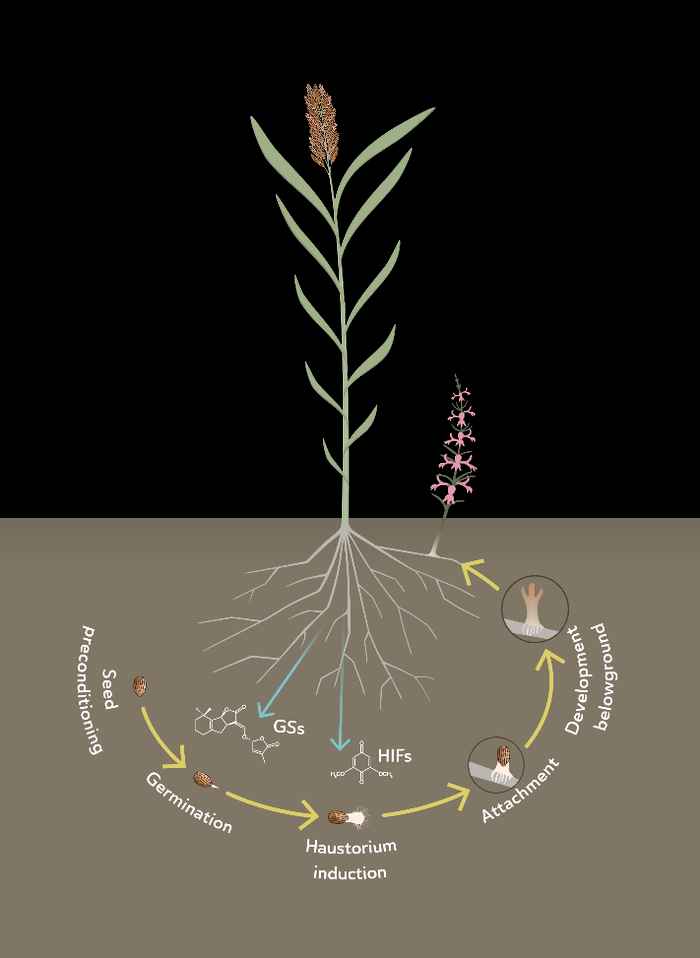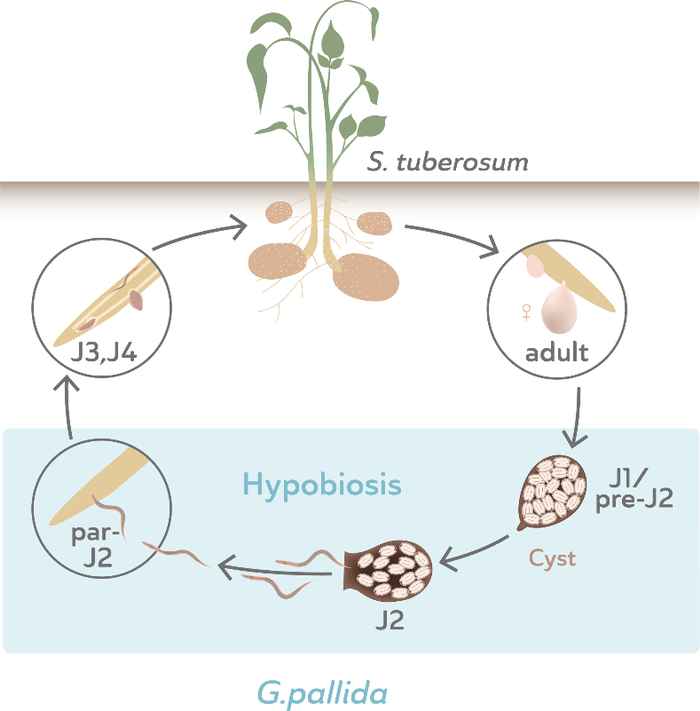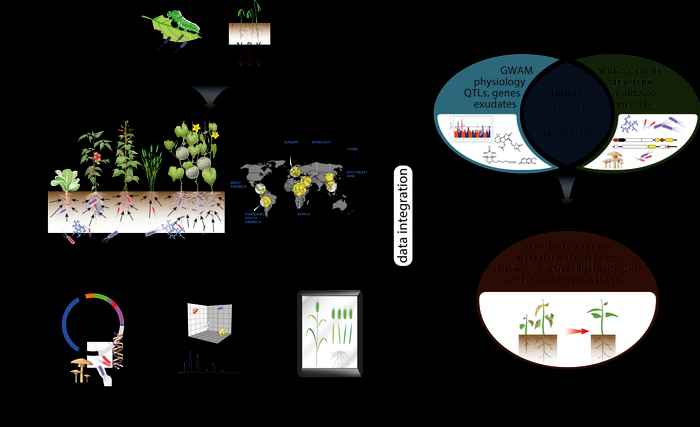Research lines Plant Hormone Biology
-
Strigolactone biosynthesis and perception
An important example of signalling molecules that are used by plants for communication in the soil, are the strigolactones. These are used by the friends of plants, the symbiotic arbuscular mycorrhizal fungi, for host detection but also by their enemies, root parasitic plants. Furthermore, they have an endogenous signalling function, as a plant hormone that regulates shoot branching and root architecture. These positive and negative signalling roles of the strigolactones could be the result of a paradigm: enemies of plants recruit molecules that are essential to the plant as cues. This paradigm has two important implications: 1) other plant-produced signalling molecules known to be abused by plant enemies likely have another, beneficial essential function in plants and 2) the involvement of multiple, positive and negative, biological functions exerts a selective pressure on these signalling molecules that results in the evolution of diversity in structure and biological specificity. With an Advanced Grant of the European Research Council (ERC; see below) we are addressing these implications. For implication 1) see Research line “Bad signaling molecules, good signaling molecules?” We study implication 2) by investigating how biological specificity in strigolactones is mediated by the creation of structural diversity and the concomitant changes in the perception by receptors, in parasitic plants. Hereto, we study biosynthesis of strigolactones in tomato, maize and sorghum (also with support of the Chinese Scholarship Council, CSC and CGIAR institute ICRISAT). With mutants and genetic transformation, we will create plants with strigolactone profiles that differ from wildtype to investigate what the biological relevance of individual strigolactones is. We also approach this from the other side by the application of strigolactones to the plant. In addition, we study the concomitant evolution in the perception of host strigolactones by Striga. For all this work, further improvement of the chemical analysis of strigolactones is essential, which we are trying to achieve through a combination of smart isolation and ultra-sensitive detection with support by NWO-ECHO. Our work on the strigolactones will shed light on the significance of structural diversity in signalling molecules and the co-evolution of perception. It should also provide the fundamental knowledge enabling biotechnological and agronomical applications to optimise colonisation by AM fungi and plant development, and control parasitation by root parasitic plants.

Chemical communication in the rhizosphere of plants
In CHEMCOMRHIZO we study the use by plants of metabolites to communicate with other organisms in their rhizosphere. CHEMCOMRHIZO is divided into two main categories of rhizosphere signaling molecules: strigolactones and nematode hatching stimulants. Within these main parts we are looking at biosynthesis and perception.
An exciting example of rhizosphere signalling molecules are the strigolactones. These are used by the friends of plants, the arbuscular mycorrhizal fungi as well as other members of the root microbiome, for host detection but also by their enemies, root parasitic plants. Furthermore, they have an endogenous signalling function, as a plant hormone that regulates shoot branching and root architecture. I postulated that this dual positive and negative signalling role of the strigolactones is the result of a paradigm: enemies of plants recruit molecules that are essential to the plant as cues. This paradigm has two important implications: 1) other plant-produced signalling molecules known to be abused by plant enemies likely have another, beneficial essential function in plants and 2) the involvement of multiple, positive and negative, biological functions exerts a selective pressure on these signalling molecules that results in the evolution of diversity in structure and biological specificity. For the strigolactones we are investigating implication 2): what is the biological relevance of the large structural diversity in the strigolactones.
For implication 1) we are studying the nematode hatching stimulants. We address this using an innovative approach in a new area for the group by setting out to discover a new signalling role for plant parasitic cyst nematode hatching stimulants, with the microbiome being a plausible candidate. We do that by elucidating their biosynthesis and looking at the consequences of knocking out their production. In addition, also for the hatching stimulants we study how biological specificity is mediated by the creation of structural diversity and the concomitant changes in perception, in nematodes.
Together, the work should shed light on the significance of structural diversity in signalling molecules and the co-evolution of perception and could result in the discovery of a new class of signalling molecules in plants, perhaps signaling the microbiome. It may also provide the basis for biotechnological and agronomical applications to optimise colonisation by AM fungi and other microbiome members or to control plant development, and prevent parasitation by root parasitic plants and cyst nematodes.
CHEMCOMRHIZO is divided into the following work packages:
WP 1. The chemistry of rhizosphere signalling
WP 2. Structural diversity in strigolactones- WP 2.1 Identification and characterisation of missing enzymes
- WP 2.2 Specificity in strigolactone rhizosphere signalling
WP 3. Characterisation of hatching stimulant biosynthesis and function
- WP 3.1 Identification and characterisation of hatching stimulant biosynthetic enzymes
- WP 3.2 In planta signalling: effect of hatching stimulants on host physiology
- WP 3.3 Ex planta signalling: hatching stimulant rhizosphere signalling
WP 4. Perception of rhizosphere signaling


-
Bad signalling molecules, good signalling molecules?
The positive and negative signalling roles of the strigolactones could be the result of a paradigm: enemies of plants recruit molecules that are essential to the plant as cues. The implication of this paradigm is that other plant-produced signalling molecules known to be abused by plant enemies likely have another, beneficial essential function in plants. In a number of projects funded by the ERC (CHEMCOMRHIZO, see under Research line “Strigolactone biosynthesis and perception”), an EU-Marie Curie fellowship (Nemhatch) and NWO-TTW we address this implication using an innovative approach in a new area by setting out to discover a new signalling role for plant produced signalling molecules that attract pathogenic organisms to plants such as nematodes. The hypothesis here is that these signalling molecules must have another, positive, function for the plant. Also with these signalling molecules we will investigate another implication of the paradigm: is biological specificity in these molecules mediated by the creation of structural diversity and how could the pathogenic organisms evolve perception of these plant produced molecules. This work should shed light on the significance of structural diversity in signalling molecules and the co-evolution of perception and may result in the discovery of a new class of signalling molecules in plants. It will also provide the fundamental knowledge enabling biotechnological and agronomical applications to control parasitation by a range of organisms.
-
Signalling to the rhizosphere microbiome?
The strigolactones are very likely just the tip of the iceberg of the signalling that takes place in the rhizosphere, of which we hardly know anything due to the difficulties of studying what goes on belowground. At the same time, we start to realize how important the rhizosphere is for plants. Especially for the root microbiome – the community of micro-organisms on and in the root of plants – it is becoming increasingly clear that it has a tremendous impact on plant growth, development and productivity and can be compared to the importance of the gut microbiome in animals and humans. To unravel signalling relationships between plants and micro-organisms we are using targeted and non-targeted approaches. With funding of the ERC we are looking at the importance of strigolactones for recruitment of (beneficial) micro-organisms. For our untargeted approach we use metabolomics in combination with metabarcoding/metagenomics. This work is jointly funded by the ERC and the University of Amsterdam Systems biology program. With funding of the Bill and Melinda Gates Foundation we study if the microbiome can protect sorghum against Striga infection and how sorghum recruits these beneficial micro-organisms through (changes in) its root exudate. In the recently funded Gravitation project MiCRop (see below), we and 5 partners in other Dutch Universities/Institutes, will investigate the role of the plant in the recruitment of beneficial micro-organisms under stress on an unprecedented scale, in 100 plant species across the 5 agriculturally most important plant families. In all these studies we use advanced omics approaches, data integration and modelling to try to discover new signalling relationships between plants and micro-organisms. To underpin these putative relationships, we will unravel biosynthesis of signalling molecules and use - engineered - genotypes/mutants/transgenic lines with altered signal molecule production for the characterisation of the role of these signalling molecules in shaping the rhizosphere community.

Microbial Imprinting for Crop Resilience (MiCRop)
A Gravitation program funded by NWO and the Dutch Government
MiCRop is a large collaborative program with PIs Harro Bouwmeester (UvA, coordinator), Marcel Dicke (WUR), Toby Kiers (VU), Corné Pieterse (UU), Jos Raaijmakers (NIOO) and Christa Testerink (WUR).
Plant roots house one of the most diverse, yet vastly neglected, microbial communities on earth. The aim of the Gravitation program, Microbial Imprinting for Crop Resilience (MiCRop), is to harness the genomic potential of root microbes as a new platform for improved stress resilience of future crops and sustainable food production.
Hereto, we will study the evolution of plant-microbiome interactions and identify opportunities for future plant breeding at an unprecedented scale. Our focus is on understanding stress-adaptive microbiomes and their active recruitment by plants across the plant kingdom through a phylogenetic approach. With precision-based methods, we will analyse the root microbiome dynamics of 100 wild and cultivated plant species - related to the five most important food crop families (Brassicaceae, Solanaceae, Fabaceae, Graminaea and Cucurbitaceae) – grown under four major types of environmental stress (nutrient deficiency, drought, pathogen infection, herbivory). This highly ambitious effort will provide unrivalled insight into the evolution and potential of wild plant and crop species across the plant kingdom to select, assemble, and benefit from their microbiomes.
We will zoom in on the discovery of novel microbiome functions that are recruited by plants to alleviate environmental stress, and get insight into wild microbiome functions in the centres of origin that were ‘lost in translation’ during centuries of crop domestication. Moreover, we will identify novel plant traits that maximise the beneficial functions of the root microbiome and overcome environmental constraints or provide protection against pests and diseases. We will capitalise on our discoveries through our collaboration with the international CGIAR (CG) institutes and partners from the green life sciences industry. Together, we will translate our scientific milestones into deliverables for the design of future microbiome-assisted agroecosystems that are more resilient to environmental stress with less input of agrochemicals.
The research in MiCRop is summarized in the diagram, see the website (link below) for more details.
At UvA we will contribute to WPs 1 and 2 with an emphasis on the Cucurbits, Solanaceae and data integration and to WP 3 with an emphasis on signalling towards mutualistic microbes, trade-offs and the underlying genetics and molecular mechanisms.

-
The role of volatiles in the communication of plants
Insects have beneficial as well as harmful effects in plants. Pollination for example is a tremendously important process that determines yield in many different crops. Although we know that insects are attracted to flowers with an array of metabolic cues such as colour, fragrance and nectar, hardly anything is known about how crucial these metabolic cues are for crop yield. Vice versa, protection of crops against insects can use either direct host plant resistance or biological control, and also here plant metabolism is crucial. These two approaches are fundamentally different in that host plant resistance depends on direct defence traits of the crop plants (such as trichomes, toxic secondary metabolites or proteins, and repellents), whereas biological control depends on antagonists or enemies of the pest organisms. For the latter it is crucial that the biological control agents are able to find their prey. Hereto, plants – upon herbivory - produce volatiles that are attractive to the natural enemies of the herbivore. The use of predators and parasitoids for biological control is receiving more and more attention and for many years it has been common practice in a number of crops in glasshouse as well as open fields. We are interested in the role of terpenes and other volatiles, and their biosynthesis, in this indirect as well as in direct defence in sweet pepper, cucumber and Citrus. We study the molecular and biochemical consequences of the engineering and the effects on the behaviour of natural enemies as well as pest insects. With support of the EU we will investigate the role of volatile and non-volatile metabolites in the resistance of Citrus against the psyllid vectors of Huanglongbin.
